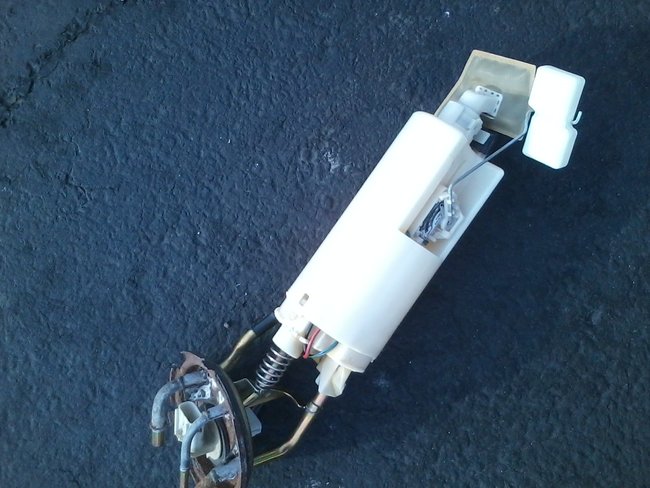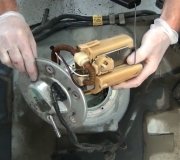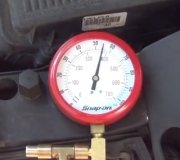You didn't say what problem or symptom led up to the fuel pump diagnosis. Knowing that, I might have saved you having to do that repair.
Starting from the beginning of your post, $800.00 is way too much for this service, but be aware, there's more than one way to approach the solution. For $32.00, you got a pump and motor that had to be transplanted into the fuel pump housing once it was removed from the tank. That's the way I do it on my vehicles, but in a minute I'll mention the strainer on the pick-up tube on the bottom of that housing. With my '88, and with two older cars with carburetors, that strainer can be replaced separately, and it is a common but elusive cause of intermittent stalling. It's common for the pump / motor assembly to come with a new strainer, but the package is going to cost more than $32.00. The clinker is on the '94 model, that strainer can not be purchased or replaced separately. The only way to get it and replace it is to replace the entire housing with the new pump, motor, and strainer already assembled and ready to drop in. Those cost a lot more than just the pump and motor, and you get a new fuel level sending unit with it. That takes care of another common problem, an intermittently-dead fuel gauge on the dash.
The next problem has to do with listening for the hum of the pump. GM fuel pumps, especially for their trucks, are very noisy and easy to hear when standing some distance away. Chrysler fuel pumps have very tight clearances and as a result, are very quiet. With two different designs, they fail in two different ways. GM pumps almost always start up, then they fail when they get warm, letting you sit on the side of the road. They also commonly fail to develop sufficient fuel pressure, and coupled with that, many of their engines will not run when fuel pressure is as little as five pounds too low. Chrysler fuel pumps rarely fail once they've started up. They fail by failing to start running, so they leave you sitting in your driveway or a parking lot. A lot of auto parts store chains buy their Chrysler replacement fuel pumps from the same supplier that built them for Chrysler, so they're just as quiet. Napa is one of those stores, and I'm sure there's others.
You're going to have to listen very closely for the hum of the pump, but then, that is only going to occur for one second when you turn on the ignition switch. If you turn the ignition switch on, then jump out and run down by the tank, expecting to hear the pump, you'll be disappointed and perhaps frustrated. There is no car or light truck model where you'll find the pump running all the time. To do so would present a serious fire hazard. If a fuel line gets ruptured in a crash, and the pump keeps on running, it will dump raw gas on the ground, creating a major fire hazard. Instead, most Engine Computers will run the fuel pump for one second to insure fuel pressure is up for starting. It should hold for weeks or months, but it's not uncommon for it to bleed down over time.
After that initial one-second pulse, the computer turns the automatic shutdown, (ASD) relay on again during engine rotation, (cranking or running). It knows that by the signal pulses it receives from the crankshaft position sensor and the camshaft position sensor. Those sensors are different between the 3.0L and 3.3 / 3.8L engines, but the fuel pump circuit is the same for all the engines.
The ASD relay sends current to the ignition coil, (coil pack in your case), injectors, alternator field, oxygen sensor heaters, and fuel pump or to a separate fuel pump relay. This means when you have a crank / no-start condition, 95 percent of the time you'll have a loss of spark, injector pulses, and fuel pump, but too many people get hung up on the first thing they find missing, and for some reason that is the fuel pump, and they neglect to look for any other things that are missing. This can be misleading too because fuel pressure will appear to be normal, thanks to that one-second pulse of the fuel pump. Some people find the missing spark, then tear that system apart, again, failing to notice there are other things that are missing. When you run into this problem of a crank / no-start condition, a quick test is to use a test light to back-probe through the dark green / orange wire at any injector, or at the coil pack, or either smaller terminal on the back of the alternator, and watch if it lights up for that one second when you turn on the ignition switch. If it does, it proves that part of the system is working. Next, it must turn on again during cranking. 95 percent of the time it will not. That indicates a problem with one of the two sensors I listed. If the light does turn on steady during cranking, the two sensors are working, and that is when you have a problem with one of the individual circuits for the fuel pump, (roughly 3 percent of the time), or the ignition system, (perhaps 2 percent of the time). The biggest initial clue here is if you can hear the fuel pump run for one second. If you do, forget looking at the fuel supply system.
Your comment about the clogged fuel filter caught my attention next. Except for diesel engines, you will never solve a running problem on a Chrysler product by replacing the fuel filter. They last the life of the vehicle unless they rust out and start leaking. That happened once on my '88, but you're more likely to run into a dry-rotted and leaking hose attached to the filter. New filters come with two new pieces of hose, and new, special fuel injection hose clamps. Don't try to use older-style hose. That's meant for cars with carburetors. Fuel pressure rarely goes higher than 5 psi. You must use fuel injection hose. It costs about $4.00 per foot at the auto parts stores, and will withstand the much higher pressures. All four of my Caravans / Voyagers run over 50 psi at times. The special hose clamps are bands tightened with a bolt and nut. The more-common aircraft style with a worm gear screw will cut into the hose and lead to a leak. This story doesn't pertain to other vehicles, GMs in particular. Those still require periodic replacement of the fuel filter.
Don't overlook the possibility you have the two hoses switched at the gas tank. I had to replace the strainer in my '88 two times, and both times I accidentally switched the hoses even though they're different sizes, ... And I'm supposed to be the expert.
Don't waste your time and money with Haynes or Chilton service manuals. They cover the common stuff, but never much related to electrical, and they never include wiring diagrams. Nothing beats a paper copy of the manufacturer's service manual. You can find them all over on eBay. I bought a lot of them from "LorieandJeff" from Tennessee some years ago for my classroom. Today they go by "Blackhatauctions". There's many others out there too. '94 service manuals have a sea green cover.
Chrysler wiring diagrams appear very confusing at first, but I can help with reading them. Only Ford's are better where they put an entire circuit on one or two pages. Chrysler puts fairly little on each page, so they have you bouncing around between multiple pages. That becomes extremely frustrating when trying to find anything on a DVD.
Getting back to dumping the gas into the tank, if you look inside, you'll see there is a metal bowl in there that the pump housing and strainer sit in. That is to prevent gas from running away from the pick-up when you go around a corner with just a few gallons in the tank. That was never a problem with carburetors because there was enough gas in the float bowl to keep the engine running for a couple of minutes. There is no such storage in the fuel supply system with fuel-injected engines. If the strainer sucks up air for just a fraction of a second, the engine would stall or at least sputter and stumble. The gas in that bowl will keep the engine running for quite a while. Once the engine is running, a really high volume of gas is being pumped, but just a tiny fraction of that is tapped off to go through the injectors into the engine. Well over 99.9 percent of that gas goes through the pressure regulator, then back into the tank. It's that gas that flows out of a tube and up a ramp, around and into the bowl. That gas flow creates a venturi effect that drags more gas along with it to keep the bowl full.
The problem is when the tank is empty, or you run out of gas, that bowl is empty, so no gas gets pumped to the engine, and no gas comes back in the return line. This is where I suspect all of your frustration started. On my '88, when I pour just a little gas in the tank, it drops from the filler tube right into that bowl. A pint of gas will get the engine started. On my '94, the filler tube misses that bowl. The gas just goes into the rest of the tank, then, it takes about five gallons before the level gets high enough for it to spill over and fill the bowl. That's when the engine will start, and from then on, the returning gas will keep that bowl full even when you're down to your last few spoonfuls of gas.
Thursday, December 5th, 2019 AT 3:49 PM




